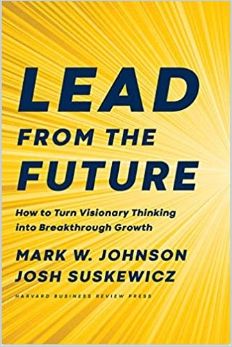Innosight’s Mark W. Johnson and Josh Suskewicz detail how every leader can develop future vision.

Visionary Thinking
Visionary leaders formulate their companies’ possible futures, but their employees act on the leaders’ vision in the present. Mark W. Johnson, co-founder of Innosight, and Innosight partner Josh Suskewicz assert that you can learn to exercise future-oriented vision and infuse it into your company, even if you serve at a conventional firm. The authors argue that leaders with a long-term view toward the future can detect emerging trends, re-envision their companies, and develop new products and approaches.
Forbes named this one of the Top Ten Technology Books of 2020; Inc. chose it as of the 10 Best New Business Books of 2020; and Success designated it one of the six Business Books You Need to Read to Level Up. The authors were Gold Medal Winners for Best Leadership Book in the 2021 Axiom Business Book Awards.
Sandi Peterson, a member of Microsoft’s board of directors, explains, “Johnson and Suskewicz have raised a battle cry for the kind of leadership we need in these uncertain times.” Admiral James Stavridis, operating executive for The Carlyle Group, believes Johnson and Suskewicz, “give leaders the tools they need to set a new course for their organizations and navigate toward a better future.”
The Future
People identify visionary leaders best in retrospect. Thomas Edison exemplifies these leaders in the industrial era, as do Bill Gates, Jeff Bezos and Steve Jobs in the digital era. Johnson and Suskewicz understand that people attribute mystical forecasting powers to such leaders, but they insist that’s a mistake.
Visionaries are simply flesh-and-blood human beings who have figured out how to develop actionable views of their organizations’ best possible futures.Mark W. Johnson and Josh Suzkewicz
Most companies, the authors lament, don’t make plans more than five years into the future; this short-term thinking makes a company vulnerable to industry changes and limits its growth. Among the authors’ themes is that extending a vision of the future beyond five years enables a company to stay at its market’s leading edge.
Johnson and Suskewicz relate that leaders often claim that small, minor changes constitute the wave of the future, so even when companies innovate significantly, they are pursuing that innovation within the limitations of their present perspective. As an example, the authors cite how early passenger trains closely resembled horse-drawn carriages; the inventors added new technology to an existing format.
Virtually every mature company tries to produce breakthrough innovations, but often what they tout as the wave of the future is just an incremental improvement on what they are already doing.Mark W. Johnson and Josh Suskewicz
They say that forward-thinking leaders, such as Gates and Bezos, think in terms of the future, and then work their way back, while sharply distinguishing between the present and future.
Phases
Future-back thinking unfolds in phases. The first phase involves formulating a vision of the future you and your people can use as a basis for action. Evaluate your vision in terms of the future’s potential impact on your company. For example, assess what your customers will care about and want, what the market will look like, and whether new possibilities might surface.
Future-back work begins with a series of structured dialogues in which senior leaders develop a compelling long-term vision.Mark W. Johnson and Josh Suskewicz
Assess how to maximize the value of your primary offerings, consider new products that might enhance the value and range of your core offerings, and outline strategies for further growth.
Portfolios
An inspiring vision of the future isn’t sufficient without a strategy for turning it into a reality. The authors recommend that the way to manifest your vision in a long-range strategy is to divide any problem into three portfolios.
The authors break down the first portfolio as financial projections translating a broad-brush vision into precise dollars and cents. The second portfolio should walk things back to the present. The third portfolio, the authors teach, concerns “innovation and investment” and includes your corporate leaders’ innovative efforts to build the organization.
Teach Future-Back Thinking
Because most companies move quickly from developing a strategy to implementing it, their leaders tend to revert to established processes, which keep them from realizing their larger vision. That’s why Johnson and Suskewicz exhort you not to allow people working on innovative initiatives to fall back on habitual practices and entrenched attitudes.
To that end, they recommend involving your top executives in all decisions on future-oriented initiatives and keeping bureaucracy to a minimum.
Without sufficient high-level attention, most breakthrough ventures won’t even get off the ground.Mike W. Johnson and Josh Suskewicz
As part of this work, companies should develop their next generation of leaders to spearhead future initiatives and ultimately lead the organization.
Vision
Entrepreneurs who start companies from scratch have an advantage because they can devote time and energy to their visions and goals.
Having a clear vision of your intended future allows you to anticipate and grasp opportunities for growth – and to stop doing things that are becoming irrelevant.Mike W. Johnson and Josh Suskewicz
Executives at older corporations, the authors explain, must operate traditional businesses while generating new offerings and approaches. This requires leaders to switch between present-forward and future-back thinking. The authors warn that these leaders can become stuck in the present and blind to the future, especially if they prioritize short-term results. However, large companies can maintain their traditional businesses and fuel long-range growth if they have vision, the crucial power for shaping the future.
Systems
Johnson and Suskewicz are acknowledged experts in this realm, but the core of their book’s utility and singularity is how they share that expertise. They break down their knowledge into simple accessible systems that seem both inspiring and surprisingly straightforward to implement. That is no small part of the authors’ gifts – their ability to make what they insist is a crucial transition seem like a logical necessity that any company or leader could undertake. Their articulate, fundamental language enables all readers to embrace their ideas and shape them into reality.
Mark W. Johnson and Josh Suskewicz also co-authored How to Jump-Start the Clean Tech Economy. Johnson, also the author of Reinvent Your Business Model, co-authored Seizing the White Space with A.G. Lafley and Dual Transformation with Scott D. Anthony and Clark G. Gilbert. The team of Johnson, Anthony, Joseph V. Sinfield and Elizabeth Altman co-authored The Innovator’s Guide to Growth. Related works include The Future Is Faster Than You Think by Peter H. Diamandis and Full Spectrum Thinking by Bob Johansen.













